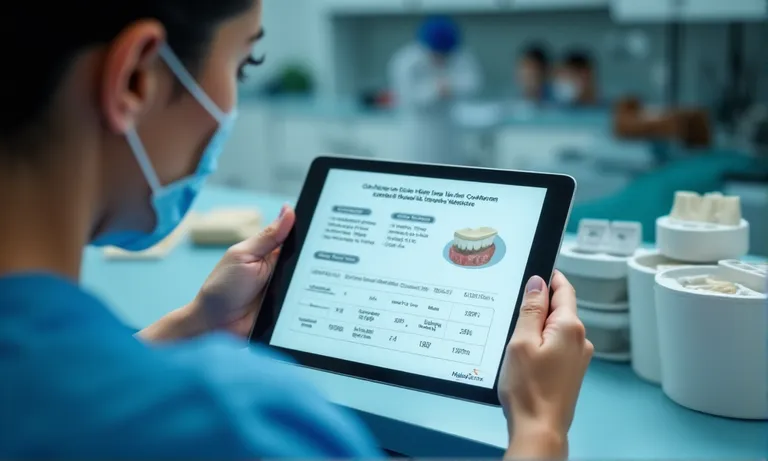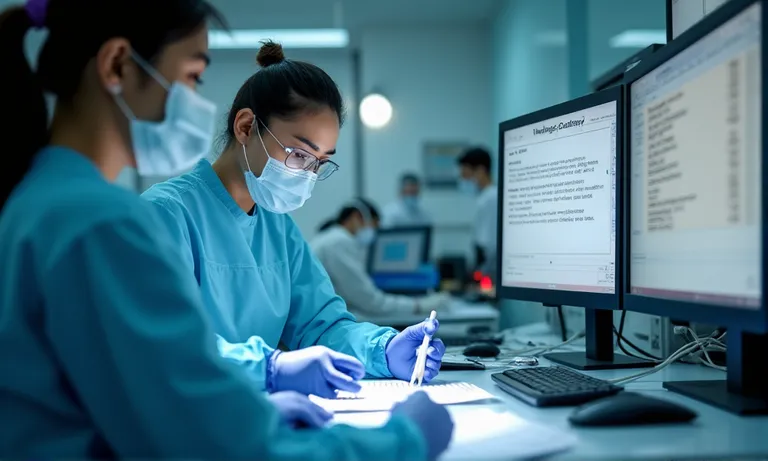Outsourcing crown and bridge work to an overseas dental lab can generate measurable ROI—but only when evaluated beyond unit price. The true return depends on a range of visible and hidden factors: logistics and customs costs, production quality, communication rhythm, and whether internal workflows are ready to scale.
Procurement leaders, DSO operators, and in-house dental labs often face practical questions:
- Which cost variables are routinely underestimated?
- How does digital compatibility impact quality and efficiency?
- What strategic value can global lab partnerships offer?
- How do we reduce risk and ensure sustainable returns?
This guide dissects the ROI of dental outsourcing into four actionable dimensions:
- Costs: Beyond base pricing—consider onboarding effort, shipping, and integration overhead
- Strategic Gains: Expand capacity, tap into digital expertise, and leverage global time zones
- Operational Risks: File misalignment, remake rates, QA inconsistency, communication delays
- Execution Levers: SLA definitions, pilot case tracking, QA loops, and case-type matching
By aligning financial modeling with workflow realities, teams can approach outsourcing as a structured investment—not a shortcut. When done right, overseas partnerships shift from cost-saving to value-building.
What Determines the ROI When Outsourcing Crown and Bridge Cases?
ROI in outsourcing crown and bridge cases is shaped by the dynamic balance between cost savings, turnaround consistency, and restoration quality. Factoring in practice size, case mix, and internal readiness is essential to calculating a meaningful return.
While outsourcing can significantly lower unit costs, especially at scale, practices must evaluate ROI through a broader lens—one that accounts for delivery reliability, remake frequency, and the actual effort needed to coordinate with an overseas dental lab. These variables differ across practice sizes and workflows, meaning ROI is rarely a fixed value.

roi-calculation-dental-lab-case-cost
Key variables: cost, delivery time, and quality outcomes
The three most impactful ROI drivers are straightforward in theory—but require careful benchmarking in practice:
- Cost per unit: Overseas labs typically offer 30–60% cost reductions. However, this varies based on material, type of restoration, and case complexity.
- Delivery time: Consistent turnaround (e.g., 7–10 working days) can boost scheduling efficiency. Delays tied to customs or lack of digital tracking erode ROI.
- Remake rate/quality: A lower remake rate (under 2%) minimizes time and cost leakage. Labs with QA loops and design confirmation systems tend to perform better.
Each of these metrics should be evaluated over time, not on a per-case basis. We’ve seen practices misjudge ROI due to early positive impressions but hidden remake rates surfacing after the first 50 cases.
How scaling case volume impacts ROI
For single-chair clinics, shipping and coordination overhead may eat into cost savings. In contrast, multi-chair or DSO networks gain significantly through volume leverage. For instance, one group practice we supported ramped from 5 to 20 cases per week over six months. This allowed them to:
- Standardize onboarding and digital file formats
- Negotiate stable pricing based on tiered volumes
- Allocate a part-time staff member to manage lab coordination, improving SLA tracking
The key is that ROI improves with systematization, not just volume.
ROI = (Savings – Costs) / Costs: applying it to dental outsourcing
Let’s apply the formula to a simplified scenario:
| Item | Local Lab | Overseas Lab |
|---|---|---|
| Avg. unit cost | $150 | $80 |
| Remake rate (per 100 units) | 6 units | 2 units |
| Avg. shipping cost (per unit) | N/A | $10 |
| Coordination/time cost | $0 | $5 |
| Total effective cost | $159 | $95 |
Using the ROI formula:
ROI = ($159 – $95) / $95 = 67.3%
This example assumes minimal integration cost. For digital practices with file compatibility (e.g., using 3Shape or Medit), initial setup is lighter, boosting ROI even more.
ROI thresholds for high-volume vs small practices
| Practice Type | Key ROI Considerations | Suggested ROI Benchmark |
|---|---|---|
| Solo Practitioner | Coordination time often outweighs savings | ≥25% |
| Small Group | Gains begin as volume standardizes | ≥40% |
| DSO/Multi-site | Operational scale amplifies ROI | ≥60% |
At Raytops Dental Lab, we typically observe that ROI stabilizes after 3–5 repeat cycles if expectations are well-aligned early on. That’s why our onboarding emphasizes not just pricing—but also delivery scope, file compatibility, and remake accountability.
ROI isn’t a static number—it’s the result of compounding operational precision.
In sum, calculating ROI is not just a matter of cost comparison—it’s a system-wide reflection of how well your practice aligns with your lab partner. As an overseas dental lab experienced in digital delivery and SLA-based partnerships, we’ve seen the strongest ROI emerge where expectations are mutual and workflows are disciplined.
What Are the Hidden Costs Beyond Unit Price?
Outsourcing crown and bridge work isn’t just a matter of comparing per-unit prices. Many practices overlook the operational and integration costs that emerge once production begins—costs that don’t appear on quotes, but directly impact chairside efficiency, lab communication, and clinical outcomes. These hidden costs can be the difference between a smooth outsourcing relationship and a frustrating experiment that erodes ROI over time.

hidden-costs-dental-outsourcing-shipping-coordination
Logistics, customs, and shipping risks
Outsourcing to an overseas dental lab introduces a new layer of logistical variables:
- Customs inspections and delays: Even with well-documented shipments, random inspections or regulatory changes can cause 1–3 day delays.
- Shipping cost fluctuations: Especially for air freight or rush orders, costs can spike depending on region or carrier.
- Damaged or misplaced parcels: Despite proper packaging, overseas transit inherently carries more risk compared to local pickup or courier.
These issues don’t occur daily, but when they do, they often happen at the worst possible time—like right before a high-value patient appointment.
Onboarding time and training curve
One of the most underestimated costs in outsourcing is the time investment required to align workflows. A mid-size practice we supported in New Zealand reported that it took approximately 4 weeks to fully calibrate scanner settings, case submission templates, and prescription documentation. During this ramp-up period, they experienced:
- 3 remake incidents due to unclear prep design communication
- Frequent email back-and-forth on case priorities
- Internal staff training to properly export STL files with embedded notes
However, once alignment was reached, remake rates dropped and submission time per case reduced by nearly 35%. This underscores why onboarding must be seen as an upfront investment rather than a sunk cost.
Communication complexity and coordination overhead
Even if English is the working language, communication friction can arise in distributed lab partnerships:
- Time zone misalignment: A 12–16 hour delay in file review or case clarification can prolong lead times.
- Channel overload: Switching between email, WeTransfer links, and chat apps makes version control harder.
- Responsibility ambiguity: Without shared case dashboards, it’s easy to lose track of remakes or special instructions.
For practices that process 10+ cases per week, this overhead compounds quickly if not proactively structured.
Cost of tech integration (if workflows aren’t aligned)
| Integration Factor | Without Alignment | With Compatibility (e.g., 3Shape, Medit) |
|---|---|---|
| File import/export | Manual zip uploads | Direct cloud sync |
| Design feedback loop | Screenshots via email | In-platform margin annotation |
| STL file compatibility | Risk of missing metadata | Preset configurations and verification |
| Tech support time | Case-by-case troubleshooting | Fewer issues with shared ecosystem |
We’ve worked with several practices who initially underestimated how much time would be spent troubleshooting scanner output. Those with existing 3Shape workflows typically integrated faster and smoother. Choosing a lab already fluent in your system reduces both tech cost and downtime.
In short, the true cost of outsourcing includes not just the unit price, but the friction involved in making the partnership work. As an overseas dental lab, we actively support early-stage onboarding by assigning a dedicated digital technician for initial case cycles. This upfront alignment, though time-consuming, significantly lowers hidden costs downstream.
Practices considering outsourcing should ask not just “What does each crown cost?” but rather, “What does it cost to make this partnership reliable?”
What Strategic Gains Can an Overseas Dental Lab Provide?
Outsourcing is often evaluated through cost lenses—but strategic ROI goes beyond saving per unit. For clinics and dental groups seeking scalable, resilient, and expertise-enhanced operations, the right overseas dental lab can become an extension of their delivery capacity. From unlocking scheduling flexibility to accessing new materials and workflows, these are long-term gains that influence competitiveness more than immediate cost savings.

strategic-benefits-overseas-dental-lab-capacity-expertise
Expand production capacity without fixed investment
One of the biggest advantages for clinics and regional labs is the ability to grow case volume without purchasing new milling equipment or hiring additional in-house technicians. This strategic capacity extension provides:
- Elastic case intake: Whether you’re launching a marketing campaign or onboarding new patients, capacity can ramp without the lag of hiring or training.
- Reduced capex: No need to invest $50K–$150K in mills, sintering ovens, or workstations to handle a 20–30% increase in case load.
- Operational agility: You can redirect internal teams toward complex anterior work while standard posterior crowns are delegated externally.
We’ve worked with a U.S.-based group that kept their internal lab lean by routing all zirconia posterior crowns to us during seasonal peaks. They maintained clinical consistency while freeing up internal resources for chairside adjustments and urgent esthetic work.
Access to materials and design expertise
Overseas dental labs that operate at scale often work with a broader range of materials than small local labs. These include:
- Multi-layered zirconia with variable translucency for more esthetic molars and premolars
- Pressed lithium disilicate systems with reinforced strength for thin-margin cases
- Pekkton and hybrid base frameworks for lightweight full-arch prosthetics
More importantly, these labs see thousands of cases weekly—meaning they often spot pattern failures earlier, refine designs based on feedback loops, and carry in-house digital teams to manage complex scans. A practice in the UK told us, “Your designer caught an occlusal interference we missed—and that’s why we trust the workflow.”
Leverage global time zones for faster turnaround
Contrary to assumptions, working across time zones can accelerate—not delay—case flow:
- Night shift advantage: Labs in China or Southeast Asia process files while your clinic is closed, enabling next-day previews or design confirmations.
- Staggered prep-to-delivery rhythm: Cases submitted in the afternoon can start production the same calendar day overseas.
- 24-hour SLA initiation: A patient’s scan sent at 5pm can be reviewed before 9am the next morning.
When synchronized well, this temporal offset acts like a second shift, expanding production time without expanding internal labor hours.
Diversify lab partnerships for supply chain resilience
| Strategy | Single Local Lab Dependency | Overseas + Local Hybrid Model |
|---|---|---|
| Capacity risk | Vulnerable to technician sick days or overload | Backup lab capacity improves load balancing |
| Material flexibility | Limited to in-stock materials | Wider access to specialty ceramics |
| Geopolitical resilience | N/A | Orders can be rerouted if disruptions occur |
| Competitive pricing tension | Difficult to negotiate terms | Market-aligned pricing through multi-source |
A DSO in California we supported diversified their restorative sourcing after experiencing three weeks of disruption due to a local flood. Our lab stepped in with pre-validated CAD protocols and matched their SLA within 48 hours. Since then, they’ve continued to operate a dual-lab model to hedge regional risk.
Ultimately, strategic gains from outsourcing crown and bridge work are about more than cost—they’re about resilience, expertise leverage, and system scalability. As an overseas dental lab working with clients in over 20 countries, we’ve seen these benefits unfold most clearly in teams that plan for agility—not just affordability.(long‑term outsourcing potential)
What Risks Should Be Considered in Outsourcing Partnerships?
No outsourcing strategy is risk-free. While overseas dental labs can provide strategic value, practices must prepare for a different set of challenges—ones not found in local partnerships. From shipping uncertainty to design file misalignment, unaddressed risks can chip away at ROI and clinical confidence. But with proper expectation setting and workflow alignment, these risks become manageable—not deal-breakers.

outsourcing-dental-lab-risks-customs-file-error-communication
Customs delays and force majeure risks
Overseas logistics introduces unpredictability—some within control, others not:
- Border inspections: Even with accurate documentation, random checks can delay cases by 1–4 days, particularly during global trade tensions or holiday peaks.
- Weather or geopolitical disruption: Events like typhoons or port closures can affect regional shipping hubs, especially in Southeast Asia.
- Paperwork mismatches: Minor errors (e.g., missing invoice codes or material classification) can trigger returns or customs holds.
A Canadian client once experienced a 6-day delay because their local brokerage firm hadn’t updated new HS codes after a customs policy change. Since then, we’ve provided them pre-filled customs templates to reduce friction.
File format or scanner incompatibility
| Workflow Element | Incompatible Scenario | Aligned Scenario |
|---|---|---|
| STL file import | Margins missing or unreadable | Preserved prep lines with annotation layers |
| Scanner output metadata | Manual input needed | Auto-imported with embedded settings |
| Articulator simulation | Not recognized by lab software | Matches lab’s design software configuration |
| Turnaround speed | Delays from clarification emails | Direct acceptance, design starts same day |
Scanner mismatch is a common oversight. If your intraoral scans aren’t exported with embedded detail (like occlusion schemes or prep design notes), the lab may revert to emailing for clarification—delaying delivery and increasing remake risk. Labs working with systems like Medit, 3Shape, or iTero often perform smoother integrations when scanner presets are aligned.
Communication friction from language/culture
Even with English as a shared medium, miscommunication happens. One European clinic submitted a rush anterior case labeled “deliver ASAP” with a handwritten note. But the message wasn’t flagged in our system, as the note was scanned but not input digitally.
Lessons we’ve learned:
- Avoid ambiguous phrases: “Soon” or “urgent” mean different things without context. Use date-based SLAs.
- Confirm read receipts: For special instructions, use platforms with acknowledgment features.
- Standardize templates: Structured case submission formats reduce cultural interpretation risk.
Ultimately, clarity isn’t about language fluency—it’s about system design.
QA process gaps: remakes, inconsistency, lack of traceability
When QA protocols differ between labs and clinics, small issues become systemic:
- Inconsistent margin design rules can lead to re-prep
- Labs without barcode-level tracking can’t trace which designer handled a case
- Lack of photo documentation hinders root-cause analysis
One DSO group in Texas halted outsourcing after three remake-heavy months—until we rebuilt their submission SOP together. We added margin confirmation screenshots, auto-tracked remake flags in reports, and reduced remake frequency from 9% to under 2.5% in one quarter.
Effective outsourcing partnerships don’t assume alignment—they verify and reinforce it through QA integration.
To mitigate these risks, clinics should adopt shared checklists, structured feedback loops, and upfront SOP documentation.For additional guidance, see dental lab quality assurance frameworks.
How to Maximize ROI in Crown and Bridge Outsourcing
Outsourcing ROI isn’t automatic—it’s the result of systematic execution. The best outcomes come from treating outsourcing not as a transactional decision, but as an operational partnership. By aligning case types, piloting first orders, defining measurable service levels, and maintaining shared reporting, practices can minimize variability and maximize long-term gains.

roi-optimization-dental-outsourcing-sla-tracking
Match the right case types for outsourcing
Not every case should be sent out from day one. Strategic ROI comes from knowing which cases are best suited for external production:
- Posterior monolithic crowns: Standardized prep design, minimal esthetic adjustments, fast turnaround.
- Long-span bridges with consistent abutments: Where strength and passive fit matter more than shade nuance.
- Non-urgent full-arch cases: Time-buffered workflows allow for remote design and multi-step coordination.
- Removable cases with digital impressions: For practices already comfortable with full digital capture.
On the other hand, highly esthetic anterior veneers with patient-specific requests often require chairside adjustments that benefit from local lab proximity.
Start with pilot orders and track performance metrics
- Select 5–10 standard posterior cases to establish baseline performance and communication rhythm.
- Define tracking variables: remake rate, margin fit, turnaround time, file error rate.
- Record internal effort: how long staff spend clarifying cases, uploading files, or reprinting prescriptions.
- Compare post-delivery outcomes: Are chairside adjustments reduced? Are remakes lower than your baseline?
A DSO in Australia we supported began with a 10-case pilot, recording metrics weekly. By the 4th week, remake rates dropped from 12% (with previous partner) to 2.8%. This data gave them internal confidence to expand.
Define SLA expectations: remake policy, lead time, support
| SLA Dimension | Recommended Minimum Benchmark | Notes |
|---|---|---|
| Remake window | ≤ 5 working days from claim | Faster if chairside deadline approaches |
| Turnaround time | 7–10 working days, door to door | Varies by region; track actual vs SLA |
| Support response time | ≤ 24 hours for file-related queries | Ideally via dedicated technician |
| Case traceability | Barcode ID linked to designer/team | Enables root cause for any remake request |
We offer SLA alignment calls for all new clients, ensuring that KPIs and tracking reports match each clinic’s internal protocols. When expectations are clearly documented, accountability flows both ways.
Maintain transparency and shared reporting systems
Performance improves when both sides work from the same data:
- Bi-weekly report sharing: Including metrics like turnaround variance, remake rate, and submission errors.
- Shared dashboards or sheets: Especially for DSOs managing multiple clinic sites.
- Tagging and escalation workflows: For recurring errors or late deliveries, visible to both parties.
One independent clinic in Toronto used to track remakes informally—until we co-developed a remake tagging system in Google Sheets with timestamps, scan IDs, and resolution notes. Within 2 months, they cut back-and-forth emails by 40% and achieved a 94% “first-pass fit” rate.
Maximizing ROI isn’t a one-time setup. It’s a recurring process of alignment, measurement, and trust-building. With the right infrastructure, outsourcing evolves from a cost-saving tactic to a performance multiplier.
When Outsourcing May Not Deliver Positive ROI
Outsourcing isn’t for everyone—and recognizing when it won’t deliver value is just as important as knowing when it will. While offshore dental labs offer compelling advantages, there are specific scenarios where external production may introduce more friction than benefit. Understanding these limitations helps set realistic expectations, avoid premature disappointments, and establish healthier collaboration rhythms when the time is right. The details can find here: When Is Crown and Bridge Outsourcing Not the Right Fit?

dental-outsourcing-mismatch-case-esthetics-digital-gap
Cases with highly customized aesthetic needs
For anterior restorations where shade, translucency, and contour require direct try-ins or in-person shading, outsourcing may fall short. Even high-resolution photos or digital shade guides can’t fully replicate the nuance of live chairside adjustments. We’ve had clients in New York share feedback like:
“We sent an 8-unit veneer case overseas with clear shade mapping, but the patient still felt they looked ‘flat’ in natural light.”
While such cases can still be outsourced with enough iterations and digital tools, the cost of perfection (remakes, shipping delay) often negates ROI. In these scenarios, working with a local partner or doing chairside mockups may be more efficient.
Low case volume without repeat orders
- Shipping cost dilution fails: When sending only 1–2 units per week, the per-unit shipping cost can rival the production savings.
- Onboarding overhead outweighs savings: With low volume, there’s little room to recoup training and coordination time.
- No performance feedback loop: Sporadic orders make it difficult to benchmark remake trends or optimize communication protocols.
Unless there’s a path to recurring collaboration, these clinics may be better served by local labs with minimal coordination effort.
Lack of internal digital readiness or workflow standardization
| Operational Factor | Not Ready for Outsourcing | Ready for Outsourcing |
|---|---|---|
| Digital scan quality | Inconsistent; rescans common | Consistent full-arch, high-res scans |
| Submission format | Manual paper + email mix | Structured case form or lab portal |
| Internal SOP or QA tracking | None or ad hoc | SLA-based expectation docs shared |
| Team coordination | Relies on one staff only | Shared team with task clarity |
We’ve seen clinics initially eager to outsource struggle during their first 10 cases due to scan cropping errors or missing prescription data. Once they updated their SOP and centralized uploads via cloud folders, remake rates dropped significantly. But until that’s in place, even the best lab can’t make up for upstream inconsistency.
Unclear expectations or absence of QA alignment
When expectations are not explicitly defined, friction multiplies. A solo clinic in California once sent 12 cases without noting their required occlusal scheme—leading to 3 remakes and 2 late deliveries. After reviewing, we discovered:
- No shared SLA document
- No standard way to flag “esthetic-priority” cases
- No mutual reporting dashboard
Outsourcing thrives on clarity. Without it, even routine crown cases become bottlenecks. That’s why as an overseas dental lab, we recommend all new clients align on remake policy, turnaround benchmarks, and case prioritization tags before volume ramps up.
Conclusion
Outsourcing crown and bridge work to an overseas dental lab can deliver strong, scalable ROI—but only when approached with operational clarity, the right case mix, and shared expectations. While unit cost savings are attractive, true value emerges from strategic alignment, robust communication, and continuous QA feedback loops.
As an overseas dental lab supporting clients across diverse practice types, we’ve seen the highest returns come from clinics that treat outsourcing as a structured collaboration—not a cost-cutting shortcut. When digital workflows, SLAs, and mutual reporting are in place, outsourcing becomes not just viable, but transformative.
For practices seeking long-term efficiency without sacrificing quality, the key isn’t outsourcing alone—it’s outsourcing well.


